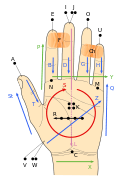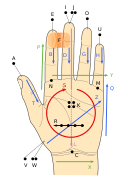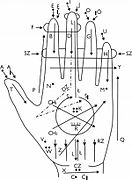Lorm alphabet
The Lorm alphabet is a method of tactile signing named after Hieronymus Lorm, who developed it in the late 19th century. Letters are spelled by tapping or stroking different parts of the listener's hand.[1] The Lorm alphabet is mostly used in German-speaking countries, the Netherlands, Czech Republic, Poland and Georgia.
Alphabet
 Lorm alphabet for German
Lorm alphabet for German Lorm alphabet for Czech
Lorm alphabet for Czech Lorm alphabet for English
Lorm alphabet for English Lorm alphabet for Polish
Lorm alphabet for Polish
For the German language the following signs are used:
A Tap on the tip of the thumb B Short stroke on the index finger C Tap on the wrist D Short stroke on the middle finger E Tap on the index fingertip F Lightly squeeze the ends of the index and middle fingers G Short stroke on the ring finger H Short stroke on the little finger I Tap on the middle fingertip J Double tap on the middle fingertip K Tap with four fingertips on the palm L Long stroke from the end of the middle finger to the wrist M Tap on the base of the little finger N Tap on the base of the index finger O Tap on the ring fingertip P Long stroke on the outside of the index finger Q Long stroke on the outside of the hand (little finger side) R Light drumming of the fingers on the palm S Circle on the palm T Stroke on the thumb U Tap on the little fingertip V Tap on the ball of the thumb, slightly outside W Double tap on the ball of the thumb X Stroke across the wrist Y Stroke over the fingers in the middle Z Oblique stroke from the ball of the thumb to the base of the little finger Ä Double tap on the tip of the thumb Ö Double tap on the ring fingertip Ü Double tap on the little fingertip CH Oblique cross on the palm SCH Lightly grasping fingers II – V ST Long stroke on the outside of the thumb
Signals
The following signals may also be used:[2]
- Word ends can be signaled by a light tap on the palm.
- Word misunderstood or request to repeat can be signaled by closing the hand into a fist.
- Mistake by speaker can be signaled by rubbing the hand. The whole word must be repeated.
gollark: if you make a credible precommitment to take revenge in advance, people might not even *cause* you to require vengeance in the first place!
gollark: What's wrong with vengeance?
gollark: > I theorise that many of the things that slow human brains down are actually required for humanlike reasoningWhat do you mean "humanlike"?
gollark: RUST REWRITE TIME!
gollark: Although current AI stuff seems to be "blindly generated" more than "programmed".
References
- Marschark, Marc; Spencer, Patricia Elizabeth (2015). The Oxford Handbook of Deaf Studies in Language. Oxford University Press. p. 338. ISBN 9780190241414.
- Białek, Maria, ed. (2009). Małymi krokami do wielkich celów: w świecie osób głuchoniewidomych (in Polish). Warsaw: Towarzystwo Pomocy Głuchoniewidomym. ISBN 978-83-925442-8-9. OCLC 751495670.
This article is issued from Wikipedia. The text is licensed under Creative Commons - Attribution - Sharealike. Additional terms may apply for the media files.